Starlink: Disrupting Tech, Science, and Geopolitics
Mar 1, 2022 12:00:00 AM • Author: Rick van Krevelen
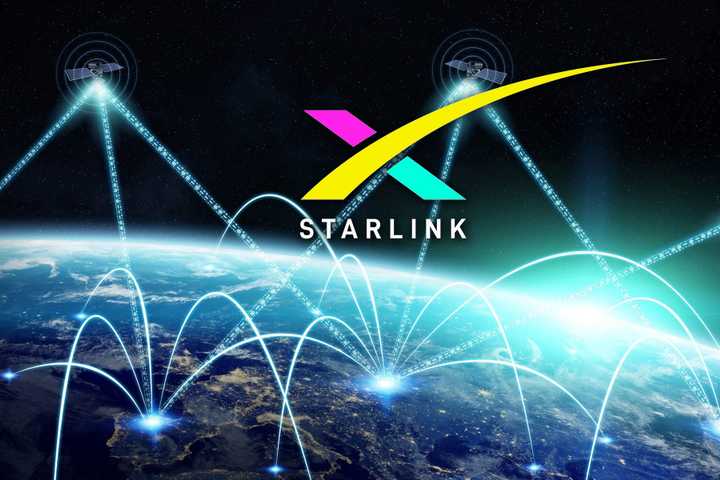
Starlink and similar satellite constellations will soon revolutionize access to the Internet, both for us and for our devices, so we tried it out!
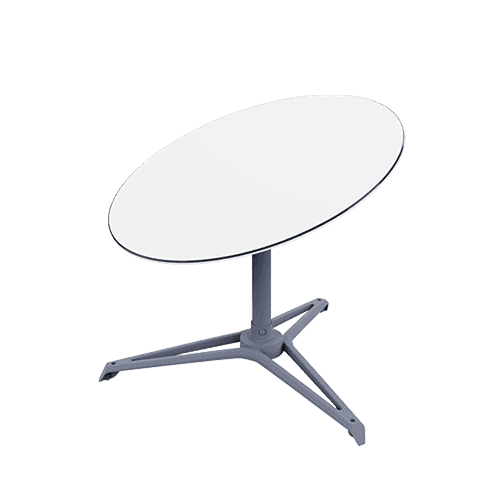
In a Netshell
Starlink offers an alternate means of accessing the Internet from anywhere on (or above) the Earth via a constellation of over 2,000 satellites, currently in low-earth orbit at altitudes of 540-570 km. The constellation will grow to over 40,000 satellites at even lower altitudes (345 km) when SpaceX's Starship, needed to launch the new Gen2 satellites, becomes operational in 2023-2024.
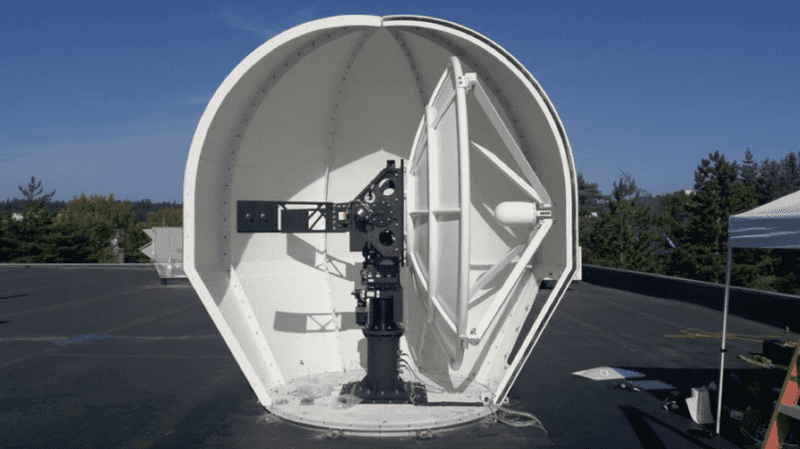
The constellation connects to the rest of the Internet via ground stations. SpaceX applied to the FCC for placing 32 ground stations in the US, and is also building ground stations elsewhere near data centers operated by Google and Microsoft.
Apart from rooftop dishes for homes and offices, Starlink also offers mobile stations that could be ideally suited for use cases like:
- Primary broadband in hard-to-reach areas (mountains, jungles, deserts, tundra)
- Primary broadband in vehicles and vessels (ships, airplanes, trucks, recreational vehicles, the Tesla Semi, etc.)
- Back-up for unreliably served areas (e.g. rural schools, companies, residences)
- Fleet management, e.g. (autonomous) vessels and vehicles (ocean clean-up, farming combines, drones and robotics, SpaceX's own rockets, etc.)
- Avoiding central choke-points (e.g. by constrictive governments)
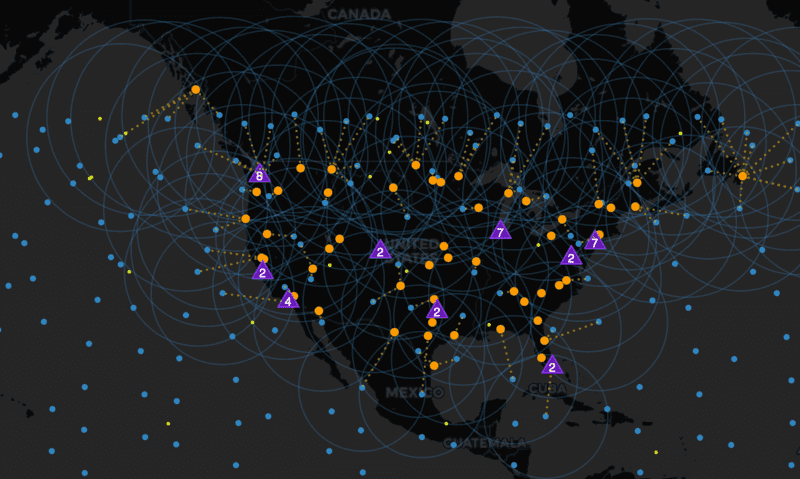
To get an idea of your local coverage, web-based visualizations like satellitemap.space or (more reource intensive) starlink.sx show which Starlink satellites are currently in range and calculate your presumed latency.
To serve ...
Selling at €99 monthly for unlimited 50-250 Mbps broadband (20-40ms latency), and €500 monthly for 150-500 Mpbs (both excluding deposit and hardware costs), Starlink leaves traditional geo-stationary satellite-based VSAT services far behind. The new constellation gets you more bandwidth and less latency than e.g. Exede (ViaSat), HughesNet, Konnect, or others (found on e.g. Satellite Signals) which offer maximum 100 Mbps download speeds at €70/mo (e.g. Konnect/Eutelsat, 600-700ms latency) or $170/mo (e.g. Exede/ViaSat, 500-800ms latency) but average speeds are much lower.
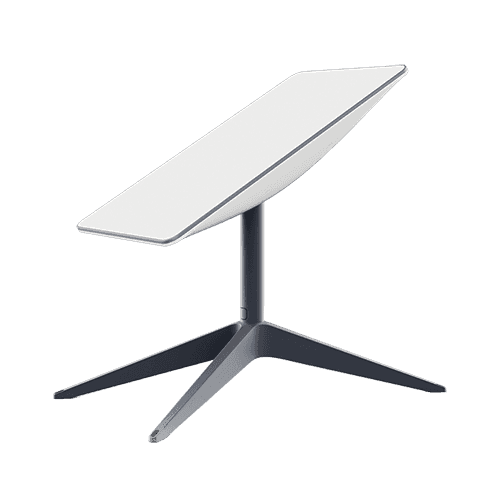
Prices are likely to go further down due to competition expected from new constellations by OneWeb (Airbus/EU/UK), Kuiper (Amazon/US), HVNet (Hughes/US), Astra (US), Telesat Lightspeed (CA/UK) and others. SpaceX takes the lead with a 4-5 year head start, but other rocket companies and agencies are in pursuit and will perhaps follow a similar timeline:
- 2014
- Early-stage planning, stealthy ITU application via Norway telecom regulator, codename STEAM
- 2015
- Starlink and OneWeb, Samsung announced constellations (e.g. Samsung 4,600 sats)
- 2016
- FCC application filed for non-geostationary orbit (NGSO) constellation of 4,425 sats
- 2017
- FCC application filed for very-low earth orbit (VLEO) constellation of 7,518 sats
- 2018
- Two prototype satellites launched, more test satellites in May 2019
- FCC approval for 7,518 sats, application to move 1,600 of earlier 4,425 to lower shell
- 2019
- FCC approved 1,600 sats
- 60 operational satellites deployed per launch, aiming for 1,584 by 2021/2022
- 2020
- Mounted on SpaceX Starship + Booster; and on Tesla Semi
- Used in Advanced Battlefield mgmt sys during a live-fire exercise incl. Boeing KC-135
- Acquired Swarm nanosat technologies
- June 18: Ximedes subcribed to Beta Test program in The Netherlands
- 2021
- FCC application for moving stations (on RV's, planes, boats, etc.)
- Feb 28: Ximedes placed order
- Sep 6: Ximedes received Starlink dish, speed test reaches 244 Mbps
- Oct 12: "Starlink serving all of The Netherlands"
- Silicon shortage push delivery to mid-2022 for millions of customers (Tesla North)
- 2022
- As of March 1: 2,187 sats launched, 1,970 in orbit, 1,555 operational (Star Stats)
A simple calculation shows that for every 1 million subscribers, SpaceX would earn a revenue of about 1M x 12 x €99 ≈ €1.2B annually. Of course, while Starlink has a "mere" 150k subscribers currently, the home-use market will soon extend to many millions, many of whom already eagerly await their own Starlink "dishy". Then there is also the corporate market, whcih is huge (e.g. small businesses, fleet operators, or financial markets), let alone the non-commercial (i.e. military) sources of revenue.
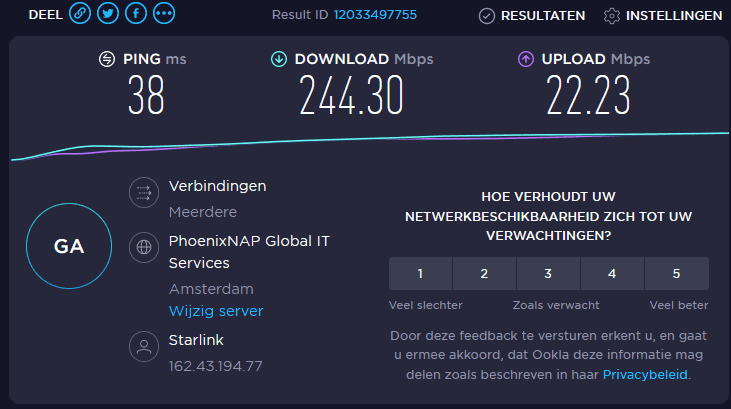
The US Federal Communications Commission (FCC) recently awarded Starlink about $900M funding from a $9 billion budget intended for providing Internet access to US citizens and companies in underserved remote areas. SpaceX serves Starlink outside the US as well, for instance rural India and the Fiji emergency zone, and is busy gathering authorization for roll-out across the globe as beta trials like the one in The Netherlands are nearing completion.
... and protect
Prior to Starlink, security on satellite-based Internet has been notoriously poor, as noted by James Pavur. After listening to 18 satellites (not Starlink) orbiting over the UK for over 2 years, he'd gathered over 4TB of (mostly unencrypted) data, including:
- A Chinese airliner receiving unencrypted navigational information and potentially avionics data. Equally worrisome, that data came from the same connection passengers used to send email and browse web pages, raising the possibility of hacks from passengers.
- A system administrator logging in to a wind turbine in southern France, some 600 kilometers away from Pavur, and in the process exposing a session cookie used for authentication.
- The interception of communications from an Egyptian oil tanker reporting a malfunctioning alternator as the vessel entered a port in Tunisia. Not only did the transmission allow Pavur to know the ship would be out of commission for a month or more, he also obtained the name and passport number of the engineer set to fix the problem.
- A cruise ship broadcasting sensitive information about its Windows-based local area network, including the log-in information stored in the LDAP database
- Email a lawyer in Spain sent a client about an upcoming case.
- The account reset password for accessing the network of a Greek billionaire’s yacht.
Unfortunately, transport-layer security (TLS) by itself is no solution. While HTTPS and transport-level encryption for email prevent attackers from reading the body of pages and messages, most domain-lookup queries continue to be unencrypted. Attackers can learn plenty by scrutinizing the data. HTTPS certificates allow attackers to fingerprint servers customers connect to.
Furthermore, virtual private network (VPN) tunnels also work poorly on traditional (MEO, GEO) satellite providers. The handshakes required for each VPN endpoint to authenticate itself to the other results in a slow-down of about 90 percent. The overhead increases the already-large (700 millisecond) latency to a wait that renders satellite Internet almost completely unusable.
With Starlink however:
- customers using end-to-end VPN encryption should not notice much TCP performance degradation because they are in Low Earth Orbit (LEO);
- footprints of LEO satellites are much smaller which cuts down on the eavesdropping threat model by a lot; and
- James Pavur thinks Starlink could easily offer a sufficiently secure satellite internet service (whether they will, remains to be seen).
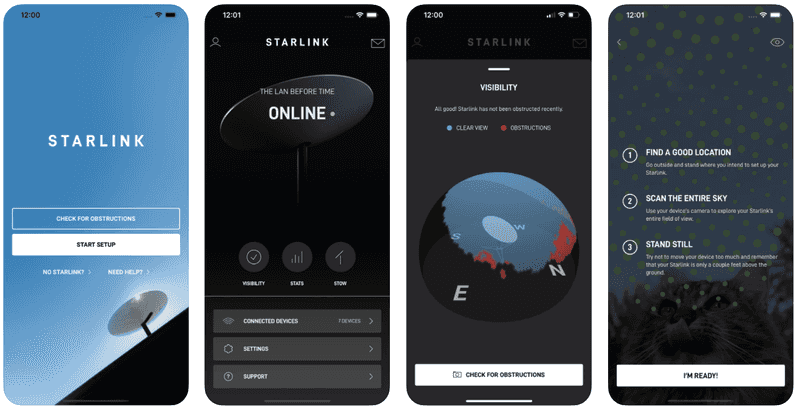
Geopolitical Impact
The Starlink program, providing superfast global Internet connectivity to anyone, is mainly a means to finance Elon Musk's efforts of "making life multi-planetary". With the profits, he is building infrastructure for colonizing the Moon and Mars, so humanity becomes more robust against extinction-level events like killer asteroids, solar storms, nuclear wars, etc. So while obtaining access to the Internet, or what the UN declare to be a catalyst of human rights, Starlink customers also indirectly contribute to helping humanity as a whole survive.
Meanwhile, Russian and Chinese governments are acutely aware that these constellations also offer military advantages, as demonstrated by recent live-fire battle excercises by the US armed forces that tested Starlink, and quickly announced their own versions (Sphere/Sfera and Starnet/GwoWang) to be launched soon.
Conversely, nations like Turkey and Iran appear to have little problems currently with their citizens using Starlink to access the Internet, since SpaceX is under US regulation and as such unlikely to "ignore" national telecom regulations (and restrictions, see this discussion), or break UN treaties like the International Telecommunication Union (ITU). Their attitude may change however, given Musk's recent support to Ukraine by delivering Starlink stations after cyber-attacks caused a Viasat network outage coninciding with Russia's invasion.
Technological Impact
Cheap and fast Internet via satellites has become possible thanks to the much lower launch costs from partly, and soon fully, reusable rockets. The scale of the Starlink project is driving advances in rocketry, telecommunications, and indirectly many other fields of research.
Using SpaceX's own Falcon-9 rocket for now, Starlink satellites are launched in batches of up to 60 at a time depending on ride-shares and fuel needed for higher insertion altitudes to avoid solar flares. Unlike previous constellation attempts, SpaceX's satellites are mass-produced and require very little fuel to reach their operational orbits as SpaceX apply neat tricks. For instance, satellites are spread across the globe and need little propulsion as they are ascended over several months and at varying rates to utilise their nodal precession (due to the Earth's equatorial bulge). This presentation by Scott Manley and animation by Jeffrey Huang (code here) shows how our planet helps to pull the batches of satellites apart and to "park" each of them correctly into their individual orbits and relative angles.
Based on Star Stats, the Starlink constellation breaks down as follows (see Wikipedia):
| Shell | Wave Band (GHz) | Version | Approved | Working | Altitude | Inclination |
|---|---|---|---|---|---|---|
| Ku (12-18), Ka (26.5-40) | V1.0 | 1,584 | 1,541 | 550.0 km | 53.0° | |
| 4 | Ku (12-18), Ka (26.5-40) | V1.0 | 1,584 | 298 | 540.0 km | 53.2° |
| 2 | Ku (12-18), Ka (26.5-40) | V1.0 | 720 | 51 | 570.0 km | 70.0° |
| Ku (12-18), Ka (26.5-40) | V1.5 | 336 + 172 | 3 + 0 | 560.0 km | (polar) 97.6° | |
| V (40-75) | 2,493 | 335.9 km | 42.0° | |||
| V (40-75) | 2,478 | 340.8 km | 48.0° | |||
| V (40-75) | 2,547 | 345.6 km | 53.0° | |||
| Gen2 | E (60-90) | V2 | 30,000 | on Starship |
There are however also concerns with managing and maintaining constellations like these.
Interfering with Science
Although Starlink's satellites have been fitted with visors to reduce reflections after initial complaints, astronomers still have serious concerns about the optical and radio interference these satellites produce. Astronomers like Becky Smethurst mentions some mitigation strategies including algorithms to reschedule observations between satellites pass-overs, for instance in an interview by Joe Scott. Full disclosure of satellite locations is required for these mitigation strategies, but this is currently not the case and hardly regulated:
“Starlink doesn't publicize all the maneuvers that they're making, but it is believed that they are making a lot of small corrections and adjustments all the time” — Hugh Lewis, Astronautics Research Group at University of Southampton
Junk at Speed
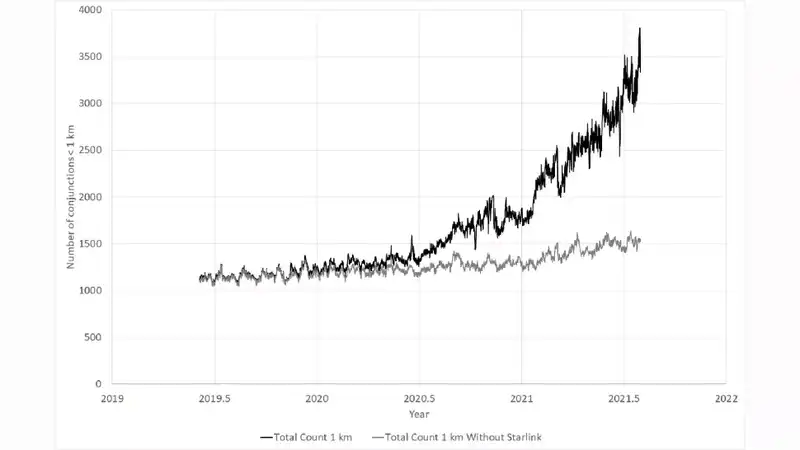
Conjunctions among satellites are becoming a major concern for regulators and operators alike. Shown in this graph based on Celestrak's SOCRATES database are weekly conjunctions of satellites passing within 1 km of each other. By the fall of 2021 about 1,700 StarLink sats had launched, causing about 1,600 weekly conjunctions between StarLink satellites and another 500/week with other satellites. Starlink satellites accounted for about 50% of all weekly conjunctions at the time, but will soon cause 90% of conjunctions when 12,000 satellites are launched, and even more when the constellation reaches 40,000 sats.
Risk of collisions is increasing, and with it the risk of collisional cascading, or the Kessler syndrome, which could render any space activities difficult if not impossible for many generations. Aspiring to be a sustainable business, SpaceX states they deorbit obsolete satellites actively within a few months, or else have them decay within 1-5 years passively. The Starlink satellites that decayed back to Earth last month within just a few days were still at their insertion altitude of about 200 km when their reorientation failed (see this breakdown of events by Scott Manley). Many constellations however operate at higher altitudes (see overview below) and debris resulting from collisions there would take decades or centuries to clear the sky. Access to space may then remain the luxury it is today, regardless of any technological and economical advances we make.
| HQ | Sats Launched | Altitudes | Latency | |
|---|---|---|---|---|
| LEO (Low Earth orbit) | ||||
| Astra | USA | 0 of 13,620 | 400 & 700 km | |
| Kuiper (Amazon) | USA | 0 of 7,774 | 590-630 km | |
| HVNET (Hughes) | USA | 0 of 1,440 | ||
| Starnet/GwoWang | China | 0 of 12,992 | ||
| Sphere/Sfera | Russia | 0 of ~600 | 870 km | |
| Spire & Myriota | EU/AU | 110 | 500 km | |
| Iridium NEXT | USA | 75 | 780 km | 980-1,800 ms |
| Telesat Lightspeed | CA/UK | 298 (+ 1,373) | 1,000 km | 30-50 ms |
| OneWeb (Airbus) | EU/UK | 218 of 648 | 1,200 km | |
| Globalstar | USA | 24 | 1,414 km | ~60 ms |
| MEO (Medium Earth orbit) | ||||
| O3b MEO (SES) | USA | 20 | 8,063 km | 140-180 ms |
| GEO (Geo-stationary orbit) | ||||
| Exede (ViaSat-1) | USA | 1 | 35,786 km | 240-280 ms |
| HughesNet (Echostar/Hughes) | USA | 1 | 35,786 km |
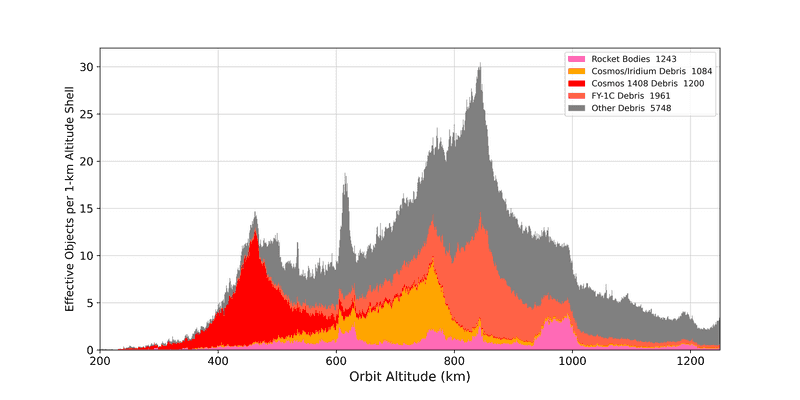
From the amount of debris, shown in the above graph per 1-km altitude shell as a function of orbital altitude, one can perhaps appreciate the need for cleanup of space debris, which the ESA already prioritizes. Furthermore, regulations are quickly being overhauled "to address a different satellite ecosystem" (Spacenews) due to this surge of non-geostationary orbit (NGSO) satellites.
TL;DR
All in all, Starlink seems to be disrupting our lives in much more ways, and on much larger scales, than we may realize. This promises many exciting new opportunites on a whole new level, and likely also in our own areas of expertise!
About Ximedes
This article is based upon a presentation I gave at Ximedes some months ago on December 14th, 2021.
Ximedes is a software house that creates bespoke software for clients, usually in the cloud-based solution that we continue to develop. Key specializations: Merchant Onboarding, Payment gateways, Merchant portals, Reconciliation & Settlement.
Do you want to find out more about how our team can help you with your software engineering challenges? Feel free to reach out!
Rick van Krevelen
Coder